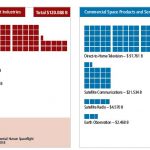Browse Resources by Year
Workforce: Space Workforce – TSR 2015 explores U.S. space, European space and Japanese space at national levels, including NASA and U.S. National Security space workforce. Related Resources Workforce: Workforce and…
Read MoreThis visualization illustrates the composition of the 2015 global space economy, which was$323 billion in size. Segments are grouped and color-coded according to the economic sectors detailed in Section 2…
Read MoreNote: The exhibit in this section is from The Space Report 2015. Please refer to this year’s exhibits for the most current data as numbers may have been revised since this edition was published.
Read MoreAn example of a country using suborbital rockets for testing is Iran, which sent its second monkey into space in December 2013. Lifted aboard a Kavoshgar-e Pazhuhesh sounding rocket to an altitude of 120 kilometers (75 miles), the capsule containing the monkey parachuted safely back to Earth. The monkey, capsule, and rocket are part of Iran’s efforts to send a human into space by 2024.
Read MoreGlobal, dedicated, and secure communications networks are vital to governments, militaries, and agencies around the world. Increased demand for capacity—particularly secure connectivity using non-commercial frequency bands—continued to drive deployment of dedicated military communications satellite systems. The U.S. military bought significant capacity from commercial operators such as Intelsat and SES in 2014. However, the way the military buys the bandwidth has been criticized by commercial satellite communications services as expensive and outdated.
Read MoreWhile many remote-sensing and Earth observation satellites can be used for reconnaissance or other types of intelligence-gathering, military-specific and government-run satellites and sensor payloads are guided by very different mission requirements and laws than their commercial counterparts. There are several intelligence disciplines, or INTs, in which reconnaissance satellites are used to gain information: imagery intelligence (IMINT), signals intelligence (SIGINT), and measurement and signature intelligence (MASINT).
Read MoreWeather satellites are a major segment of remote sensing satellites, using a mix of electro-optical, atmospheric, gravimetric, SAR, and other sensor payloads to detect fully formed weather systems as well as precursor conditions. Most weather satellites are in GEO or polar LEO orbits and have traditionally been operated by national governments for near-term weather forecasting and long-term climate modeling.
Read MoreCollectively, land-imaging satellites are systems used to observe, monitor, and track changes and developments on the Earth’s surface using a variety of optical or electronic imaging capabilities. Earth observation satellites may be distinguished from each other on the basis of spatial resolution—the level of detail their images are capable of recording. Another distinction is the sensor type, such as optical cameras, synthetic aperture radar (SAR), or various types of infrared and electronic imaging.
Read More